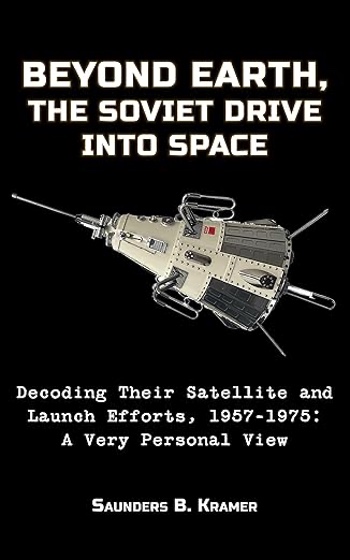Review: Beyond Earth, The Soviet Drive Into Spaceby Dwayne A. Day
|
| It isn’t quite right to call him an amateur, but he was not paid for his assessments of the Soviet space program; that was a hobby. |
One of the lesser-known space sleuths was Saunders B. Kramer. Although he was a contributing editor at Air & Space magazine, Kramer did not publish much. But because he had degrees in physics and mathematics and was a working engineer at Lockheed, he had a bit of an enigmatic reputation among some of the other space sleuths. Kramer was no amateur. But what was he, exactly? Now his memoirs have been published, and they’re intriguing, but also frustrating.
Saunders B. Kramer was born on October 30, 1920, and died on May 30, 2005. Born and raised in Brooklyn, New York, by 1955 he moved to California to work for Lockheed Missiles & Space Division. He served as the first director/manager of a crewed space station design. He worked on concepts for lunar and planetary bases and spacecraft. But Lockheed was not a major contractor for NASA programs and much of the company’s work was on military and intelligence space programs. Kramer also was involved in work on the Polaris missile.
Kramer was avidly interested in the Soviet space program and collected as much information about it as he could, and applied his considerable analytic skills to understanding each new development. However, this was not his profession, and it does not appear as if Kramer had access to intelligence information—including that collected by Lockheed-built satellites—on the Soviet space program. It isn’t quite right to call him an amateur, but he was not paid for his assessments of the Soviet space program; that was a hobby.
The book covers the period 1957 to 1975, and is essentially Kramer’s journal of those years trying to determine what the Soviets were doing with various space and missile efforts at a time when information was incredibly scarce. If Kramer had access to intelligence sources, many of the musings in this journal would have been answered. For example, rather than wondering if the Soviets had a massive lunar rocket, he would have seen satellite photos of it on its launch pad.
The topics covered in the book include the Vostok 1 and 2 missions, early Venus and Mars spacecraft, weather satellites, early robotic lunar missions, the Zond circumlunar missions, the Fractional Orbital Bombardment satellites, and others. By the mid-1970s Kramer also speculated on the future of the Soviet space program, including its space shuttle that did not fly until over a decade later.
The book should be read as a contemporary source, not a corrected or annotated one. Many of the questions Kramer posed more than 50 years ago have long been answered, and some of his categories, such as “maneuverable satellites” have now been identified for what they were. Thus, what you see is how a well-educated and knowledgeable person at the time assessed the publicly available information. This was the best that anybody could do without access to intelligence sources.
| Kramer’s book might be useful as a training tool to compare what was known then about the Soviet space program with what was really happening. It could, if read carefully, help readers realize some of the limitations to understanding when information is kept secret by foreign powers. |
It is difficult for today’s reader to understand the context of these times, when the only information about a Soviet space launch might be its initial orbit and its Cosmos number. Kramer’s book provides some insight into that context, but not a lot. The Soviet Union usually only provided information on successes and was silent about failures. People like Kramer and Jim Oberg were the ones who helped the general public understand that a satellite launched at a certain time might have been heading to Mars or the Moon, even if it failed and the Soviet Union never mentioned it.
I never encountered Kramer, but decades ago I heard some people talk about him as if he was a space sleuth with mystical powers, that because he had worked for Lockheed, he must have known more than he was saying, and what he was saying must have been right. That does not seem to be the case. Kramer was smart and knowledgeable, but did not have the “tickets”—security clearances—to get access to better information than the general public. If he did, he would not have been able to write about it at all.
Kramer’s book might be useful as a training tool to compare what was known then about the Soviet space program with what was really happening. It could, if read carefully, help readers realize some of the limitations to understanding when information is kept secret by foreign powers. What can this tell us? How can we sharpen our skills to understand what is going on right now with the Chinese and Russian space programs? But primarily it is a reminder that at one time, the space race was dominated by mystery and secrecy.
Note: we are now moderating comments. There will be a delay in posting comments and no guarantee that all submitted comments will be posted.
